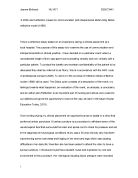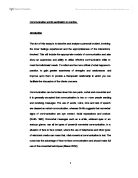My initial feelings were mixed,firstly there was the feeling of excitement and intrigue at the idea of being involved in the clinic and learning new skills. I started to feel anxious when the doctor began asking me questions and involving me in the procedure. There was a clear language barrier which made me feel embarrassed and uneasy. My feelings changed again when Mary became distressed and upset. Finding myself alone with her in quite an emotional state made me panic and unsure of what to say. I also felt anger towards the doctor who arguably had put me in this awkward position. As a first year student with limited knowledge I did not feel able at to question the doctor with regards to her approach. At this point my feeling was that of frustration. Not wanting Mary to sense my uncertainty my thought was to stay calm and try to resolve the situation. Sitting face to face so that I could show her that I was listening to her and the use of touch as empathy brought about a calming effect. Feeling more at ease by her response and by using knowledge already gained in theory made me feel more confident and comfortable in my ability. My calm approach and that of the second doctor put Mary at ease and quickly turned the situation around to a more positive one.
On evaluating the incident it made me realise that although the initial outcome seemed bad the end result was in fact a good one. My belief is that the doctors lack of compassion towards Mary was some what unprofessional and contributed towards her anxiety and frustration.The doctors lack of clear communication escalated the situation and created Mary's unease.The doctor should have listened to her concerns and not ignored the way she was feeling in order to control the situation and ensure a positive outcome earlier. One point of view is that poor communication is a common cause of many healthcare complaints (Cambell, 2006). These could easily be eliminated by taking time to communicate information well along with listening and offering emotional support (Smith,Dickens,and Edwards, 2005). In my opinion all turned out well due to myself and the second doctor actively listening to Mary,using clear verbal communication and showing empathy. This approach was clearly beneficial to Mary as she felt more relaxed and able to continue with the procedure.
As human beings one of the most important skills we share is our ability to communicate. The strength of any relationship is often determined by effective communication and the nurse and patient relationship is no different. In fact the ability to communicate well is regarded as a key element in the essence of care (DOH, 2003). Communication is an essential skill required to build lasting and trusting relationships with patients and can determine patient satisfaction,compliance and recovery (Chant,Jenkinson,Randle, and Russell, 2002). Due to the fact that effective communication is regarded as an essential skill in nursing only students that have gained competency in this area will be permitted to go on and register as a qualified nurse (NMC, 2008).
Whilst communicating with Mary a range of Interpersonal skills were utilised. These included the use of verbal and non verbal communication. Non verbal communication is the art of transmitting information without actually speaking (Hargie and Dickson, 2004). Even when saying nothing at all as long as your patients are aware that you are actively listening to them can mean a great deal and demonstrate empathy towards them. Empathy is about making a connection with your patient and fully understanding their pain and discomfort.(Egan, 2002). Wagner (2006) also reported that this alone is highly beneficial to the patient, a valuable use of your time and a great way of building a therapeutic relationship.It was easy for myself to see by the look on Mary's face that she was distressed and experiencing some discomfort. Although Mary also expressed her concerns verbally, the doctor was unable to read her body language or facial expressions as she was positioned at her rear. Being in a position to read her body language and facial expressions enabled me to approach Mary with empathy and In order to try and calm the situation and talk to her about what she was so worried about I used the acronym SOLER by (Egan, 2002).This process uses body language to actively listen to a person. By sitting squarely towards Mary, keeping my posture open, leaning in towards her, maintaining eye contact and having a relaxed posture, encouraged her to relax and feel less intimidated and therefore talk more openly about her concerns. Although clearly upset by her experience she soon opened up and the verbal communication was made easier. We were able to talk freely to one another with no awkwardness. I felt comfortable enough at this stage to also use touch by holding her hand. Throughout the conversation with Mary I was also aware of the pitch,tone and volume of my voice as this can enhance the meaning of the spoken words. (Journal Of Phonetics, 2006). There is no point in saying something if the tone,pitch or volume of your voice is going to change the meaning of your words. They could easily be interpreted as uncaring and meaningless making the patient feel ignored and under valued.
In my belief the barrier in communication throughout the incident with Mary came from the language difference between her and the doctor which contributed to the lack of initial understanding of the procedure. It is important for all health care professionals including doctors and nurses to communicate effectively taking into account cultural,social and environmental factors. This will ensure individual safe care and treatment is always delivered (Berry, 2006). When there is something in the way of a patient achieving a positive outcome they can easily become frustrated with occasional outbursts of anger. All this can be avoided by just being self aware and in touch with your patients.(Nursing Philosophy, 2006).
To conclude it is clear to me that the nurse plays an extremely important role in communicating with patients throughout their treatment. Any admission to hospital can be worrying and distressing so a full assessment should be made taking into account any emotional and psychological support that may be required (Journal of Quality and Patient Safety, 2003). Roper, Logan & Tierney (2000) introduced the model activities of daily living which is a tool used by nurses today to fully assess their patients abilities and needs. Taking this time at the beginning could enhance the patient experience, reduce anxiety and prevent any misunderstandings. It may be that if Mary had fully understood the procedure she was about to have she would have been better prepared psychologically reducing the amount of stress caused. Throughout the overall experience and on reflection I have learnt that communication is an essential skill required in nursing and needs as much practice and consideration as possible. It has also proved to me that if the principles of good communication are put into practice and that the focus stays clearly on the patient, distressing and difficult situations can be moved on quickly and with a positive outcome.
My belief is that my actions throughout the incident where completely patient focused and would use the same approach again should a similar situation arise in the future. Perhaps next time having more knowledge and experience I would feel able to challenge the approach of the health care professional.
The use of Gibb's reflective cycle has aided me to make full sense of the situation and put a lot into perspective. Although the experience ended in a positive way for both myself and Mary it could easily have ended differently. This learning experience has given me the ability to recognise when a patient is uncomfortable and needs emotional support. It has highlighted the importance of listening skills and picking up on the non verbal messages that are being communicated. It has also enabled me to realised the need to increase my knowledge of communicating where there is a language barrier and with patients from different cultural backgrounds. Doing this would further enhance my communication skills and assist me in my future practice as a professional nurse. In order to increase my knowledge further my intention is to read more literature on this area of the subject as well as watch and listen carefully to how already qualified staff deal with
these situations and the responses they achieve. I will also look at building on my confidence when dealing with more challenging situations. My feeling is that I can do this by stepping up and getting actively involved when one arises in the future, using the skills and knowledge already gained.
Reference List
Andruski,J,E. (2006) Tone clarity in mixed pitch/phonation-type tones Journal of phonetics. Vol.34, No.3, pp. 388-404.
Berry, D. (2007) Health communication:Theory and practice. Open University Press. England.
Cambell,S. (2006) A project to promote better communication with patients Nursing times. Vol 102, No.19, pp. 28-30.
Chant,S.,Jenkinson,T.,Randle,J and Russell,G. (2002) Communication skills: some problems in nurse education and practice Journal of Clinical Nursing Vol 11, No.1, pp 12-21.
Clark,P,A., Drain,M and Malone,M. (2003) Addressing patients emotional and spiritual needs Joint Commission Journal on Quality and Safety, Vol 29, No.12.
Egan,G. (2002) The skilled helper. A problem-management and opportunity-development approach to helping (7th Ed) California:Brooke/Cole.
Gibbs,G.(1988) Learning by doing: A guide to teaching and learning methods. Oxford: Further Education Unit.
Department of Health (2003) The essence of care,Patient focused benchmarking for health care practitioners. London: The stationary Office.
Hargie,O and Dickson,D. (2004) Skilled Interpersonal Communication:Research Theory and Practice (4th Ed) London:Routledge.
NMC (2008) The Code: Standards of Conduct,Performance and Ethics for Nurses and Midwives. Nursing and Midwifery Council, London.
Maatta,S,M. (2006) Closeness and distance in the nurse-patient relation: The relevance of Edith Stein's concept of empathy Nursing Philosophy Vol 7, No.1, pp 3-10.
Roper,N.,Logan,W,W and Tierney,A,J.(2000) The Roper-Logan-Tierney Model of Nursing:Based on Activities of daily living. Elsevier Health Sciences, Edinburgh.
Smith,C.,Dickens,C and Edwards,S (2005) Provision of information for cancer patients: An appraisal review European journal of cancer care Vol 14, pp 282-288.
Solvoll,B,A and Heggen,K,M.(2010) Teaching and learning care – Exploring nursing students’ clinical practice Nurse education today Vol 30, No.1, pp 73-77.
Wagner,M,W. (2006) Exploring the therapeutic relationship - A practical guide for todays physician (1st Ed) USA.








